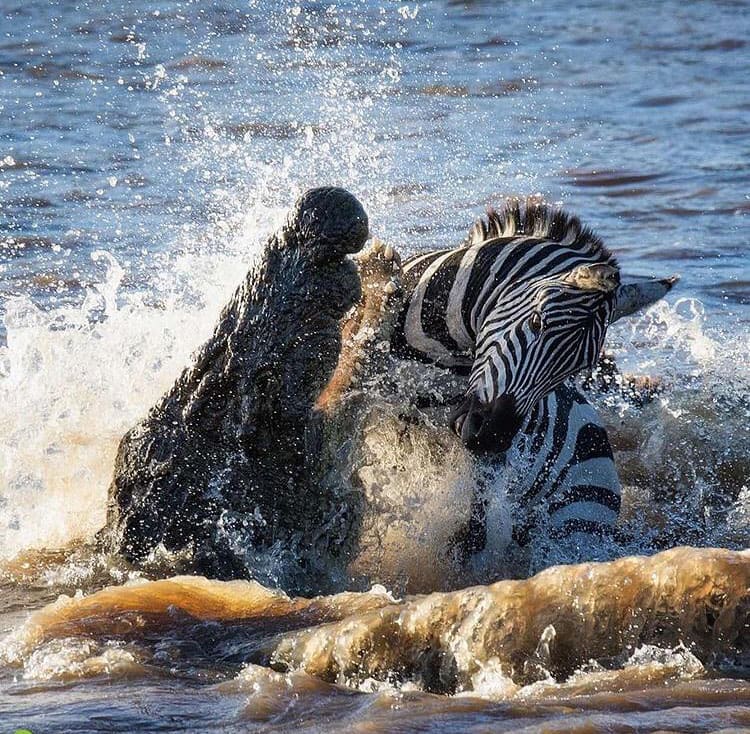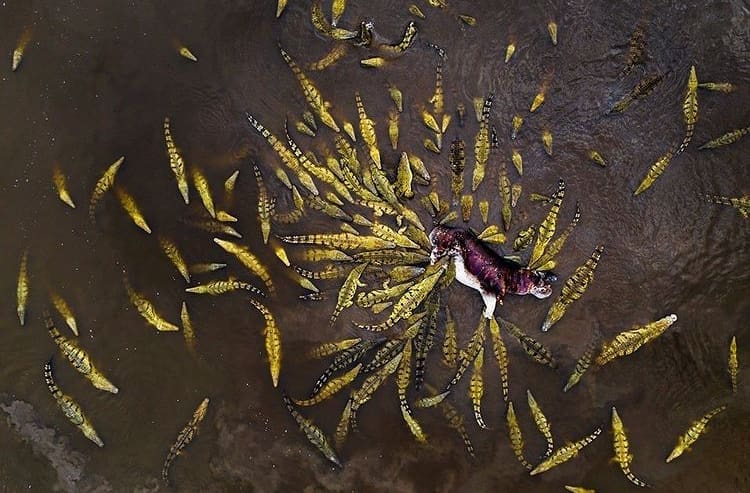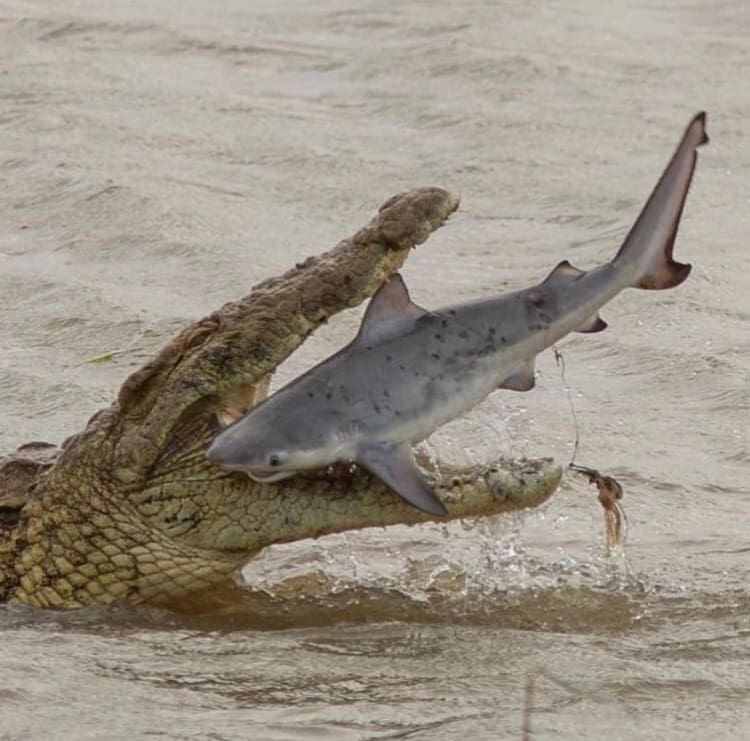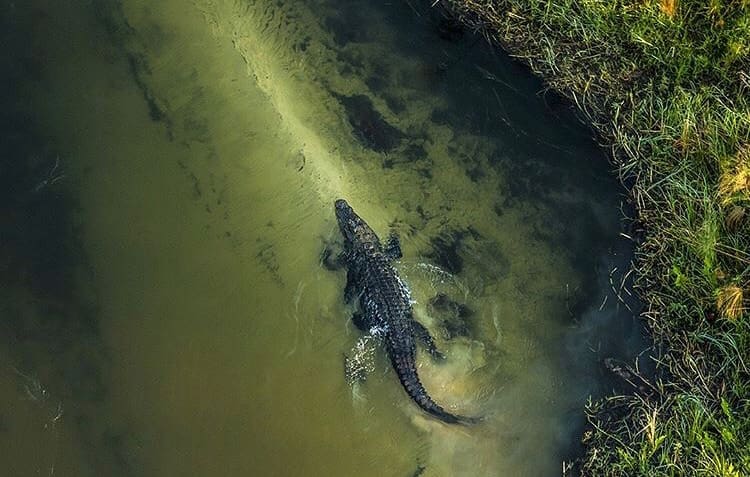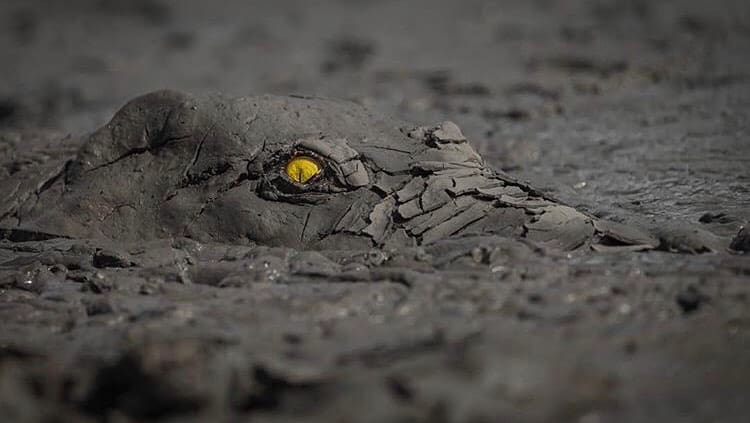One of the oldest living species on earth, the Nile crocodile is a direct descendant of the ancient dinosaurs.
These giant aquatic predators strike fear into the hearts of many, and for good reason!
What is the Nile Crocodile?
The apex predator of Africa’s inland waterways, the Nile crocodile carries a fearsome reputation among those who live in close quarters with them.
The Nile crocodile is the second largest reptile species on earth, after another crocodilian – the saltwater crocodile.
They are large and aggressive, a dangerous combination, and pose a great threat to humans and animals alike.
Crocodile vs Alligator
Crocodiles and Alligators are very similar in appearance so don’t be too hard on yourself if you’re unable to tell the difference!
While both grow to giant adult sizes, crocodiles are the larger of the two and reach longer lengths. Alligators tend be be bulkier and broader.
The most obvious differences are colouration, snout shape and geographic location. A crocodile’s snout is slender and triangular in shape, while an alligator’s is broad and round.

An alligator’s skin is dark grey or black, while crocodiles are green or olive in colour.
Regarding location, the natural range of alligators and crocodiles do overlap to a degree. Alligators are only found in America, where both native and invasive crocodile species occur. However if you see a crocodilian in America, it is more than likely an alligator.
While fundamentally the alligator and crocodile are quite similar, the Nile crocodile has many features that make it stand out.
Appearance
How Big Is The Nile Crocodile?
With reptiles, females are usually bigger than males, however this is different in crocodiles. A large male Nile crocodile can grow to over 20ft. (6m+) long from their snout to the tip of their tails, while the average adult female grows to between 9 and 12ft. (3-4m).
Crocodiles are thick, heavy built reptiles and the weight of a Nile crocodile varies according to their length and gender.

A 20 foot male can be as wide as 5ft. (1.5m) at the belly, and tip the scales at more than a tonne. The weight of an adult female is usually significantly less at between 220 and 660lbs. (100-300kg), but exceptionally large individuals do occur.
Nile Crocodile Skin
Crocodiles have thick, leathery skin that functions like a reptilian armour. Their colouration is dark or olive green, but fades into grey as they get older. They are also covered in black/brown markings. Reptile skin became popular during the mid 90’s and Nile crocodile skin was one of the most popular sources of reptile leather.
How Many Teeth Do Nile Crocodiles Have?
Nile crocodiles have between 64 and 68 teeth. They are thick, slightly curved and conical, designed to inflict maximum damage. Their teeth are spread out fairly wide apart and are a mix of smaller and larger teeth.
They have immense bite force, and once their teeth have sunken into a prey item, its near on impossible to loosen their grip.

Nile Crocodile Tail
Nile crocodiles have a thick, long tail which extends to around the same length as the rest of their body. Their tail shares the same colouration and patterning as the rest of the body, and is lined with parallel rows of plate-like scales on either side. The modern day version of spikes down a dinosaur’s back.
These powerful tails propel them through the water and can generate a lot of force, including allowing them to launch three-quarters of their body directly out the water.
This behaviour is mainly observed in tourism areas where crocodiles are fed, but can also be seen in wild feeding behaviour. When in the water, the crocodile’s tail is the main driving force, although they do also have webbed-feet.
When on land, a crocodile will also use its tail as a powerful whip to push a potential threat/prey towards their mouths.
Behaviour
Nile crocodiles spend much of their time basking on river banks or small islands. Typical for reptiles, they are unable to control their internal body temperature, and this has to be done by lying in the sun.
They can be seen basking for hours on end, often with mouths wide open. They do this to allow excess heat to leave their bodies through their mouths and avoid overheating.
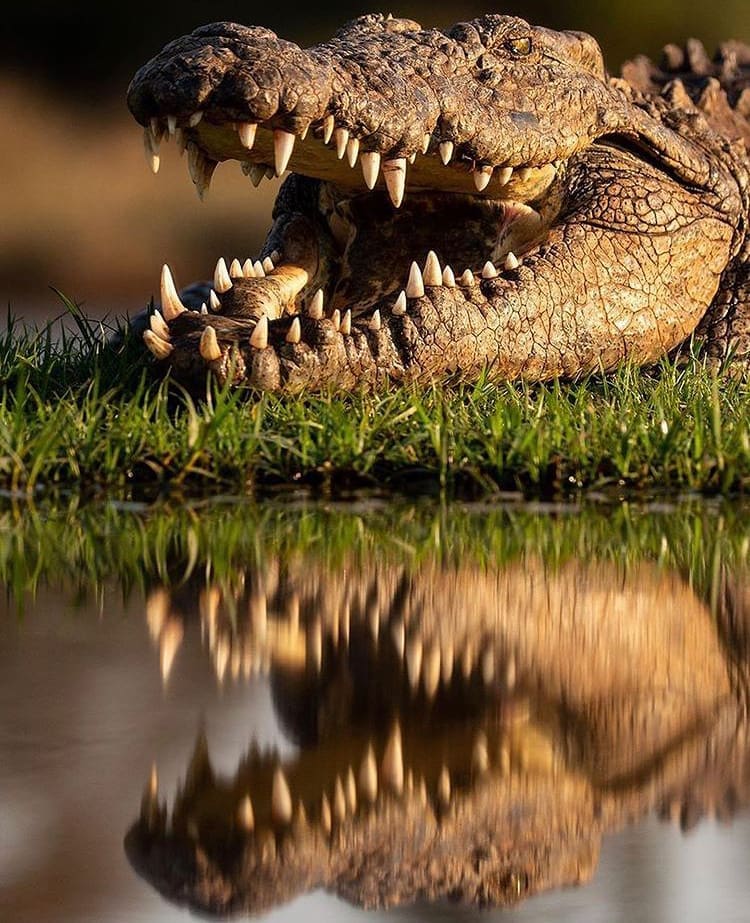
What Do Nile Crocodiles Eat?
Nile crocodiles are carnivores that will take the opportunity to kill, steal or scavenge almost anything they can get their jaws around.
When young their main prey items include insects, crustaceans, amphibians and fish. As they get older, their prey items get large. A mature adult’s diet consists of fish, birds, antelope and other mammals that visit the water’s edge.
In Kenya, the crocodile population has some of the largest individuals on the continent. Particularly in the Mara River, where they routinely hunt and kill wildebeest and zebra as they cross during the Great Migration.
How Do Nile Crocodiles Hunt?
Crocodiles are ambush hunters. They conceal themselves in the water and wait patiently for a potential victim to present itself. They can lay motionless for hours, with nothing but their snout exposed.
To an unsuspecting animal, this looks like nothing more than a log or piece of driftwood and a 16ft. (4m) crocodile can easily conceal itself in just 2ft. (60cm) of water.
Crocodilians have also developed a third eyelid which helps protect their eyes while underwater. This ‘lens’ effectively acts like a pair of goggles and does not inhibit the crocodile’s vision at all.
When prey get close enough, the crocodile launches out the water and grabs the nearest body part in their powerful jaws. With a firm grip, they will drag their victim into the water and proceed to drown them before beginning to feed on the carcass.
Crocodiles have been observed ‘hiding’ food items, before returning back to feed later on. Their jaws are not designed for chewing, and a common feeding behaviour observed in crocodiles is the ‘death roll’, which is how they dismember a carcass.
Grabbing onto a bit sized piece of the food item, the crocodile will proceed to spin violently until they’re able to rip the piece of flesh off the main carcass. On large carcasses like hippo or elephant, its not uncommon to see multiple crocodile eating and death rolling at the same time.
In addition to their adapted eyelids, crocodiles have a specialized one-way valve at the base of their throat. This allows them to swim with an open mouth, or with a struggling prey item, and not ingest any water.
How Fast Are Nile Crocodiles?
Crocodiles are surprisingly fast, even large adults.
In the water, their powerful tails can propel them at around 20 miles per hour (32km/h). On land, they’re no slouch either as even a hefty adult Nile crocodile can reach running speeds of over 10 miles per hour (16km/h) over short distances.
Nile Crocodile Social Structure
Nile crocodiles are a solitary species but tend to congregate in groups. While they don’t actively show affection, studies have suggested that they do prefer to be around others of their own species.
Large numbers will share basking sites, and cooperative hunting strategies have even been witnessed. This involves herding fish into shallow water and snapping up as many as they can. The largest croc eats first!
They have a strict hierarchy that is determined by size. The largest males will fight for dominance and access to females within a specific damn or area. Fights can be brutal and often result in lost limbs or ripped off jaws.
Dominant males are extremely territorial and will claim an area for themselves. This includes a bank or land area, and can even span over an entire pond depending on its size.
How Do Nile Crocodiles Communicate?
Crocodiles communicate using a range of calls and deep hisses. An threatened adult will give off a loud belly hiss which sounds like a high pressure wind going through a large barrel.
Hatchlings begin vocalizing even before they hatch, and emit a deep throat call.
Nile Crocodile Reproduction
After mating, a female crocodile will start seeking out the best nest site on which to lay her eggs. These nests are usually made on sandy river banks, a safe distance from the water. Females will dig a hole around 2ft. (60cm) in the sand and will return to the same nest site every year.
When ready, she will lay between 20 and 80 eggs into the hole before covering it back up with sand. She will then intermittently guard the nest site for around 90 days, in attempts to ward off monitor lizards, hyena and baboons which are all known nest raiders.
When hatchlings begin to call and poke their heads out of their eggs, the female will dig open the nest and assist any babies that are struggling to breakthrough the rubbery egg shells.
Once out the eggs, the mother will carry her babies to the water using her mouth. They will live together for 6-8 weeks before the youngsters start to move off on their own. The first few months are the most dangerous time of a crocodile’s life as they are prey upon by birds, fish, lizards and other crocodiles.
Adult crocodiles have no natural predators other than larger crocodiles.
Habitat & Range
Where Do Nile Crocodiles Live?
Nile crocodiles spend the vast majority of their lives in the water. This along with a basking spot and food source are all they need to thrive. They can be found in lakes, dams, rivers, estuaries, marshes, floodplains and have even been seen in the sea!
They are one of the most widespread species on the continent, and can be found in most of central, southern and east Africa. Even the island of Madagascar.
The full list of countries the Nile crocodile is found in is: Angola, Benin, Botswana, Burkina Faso, Burundi, Cameroon, Central African Republic, Chad, Congo, The Democratic Republic of the Congo, Côte d’Ivoire, Egypt, Equatorial Guinea, Eritrea, Eswatini, Ethiopia, Gabon, Gambia, Ghana, Guinea, Guinea-Bissau, Kenya, Liberia, Madagascar, Malawi, Mali, Mauritania, Mozambique, Namibia, Niger, Nigeria, Rwanda, Senegal, Sierra Leone, Somalia, South Africa, South Sudan, Sudan, Tanzania, Togo, Uganda, Zambia and Zimbabwe.
Conservation
How many Nile crocodiles are there in the wild?
Crocodiles are one of the hardest animals to survey, and therefore estimate ranges are quite broad. It is thought that there are currently between 250,000 and 500,000 wild Nile crocodiles in Africa.
Is the Nile crocodile endangered?
The Nile Crocodile is not currently endangered. Due to its widespread population and stable size, it is currently listed as ‘Least Concern’ on the IUCN red list.
Threats to the Nile crocodile in Africa
Between 1940 and 1960, the Nile crocodile was hunted to the brink of extinction. This was a joint effort between European trophy hunters, and the leather industry. Since then, conservation efforts and farming have brought about a massive recovery in the wild population that is now no longer under pressure.
Today, the main threats facing Nile crocodiles in the wild is habitat loss, water pollution and human conflict.
In many parts of Africa, human populations rely heavily on natural water sources and this brings them into regular contact with crocodiles. Conservation authorities are working on finding sustainable solutions to prevent these people from being in danger of crocodiles, and in turn preventing crocodiles from being killed by humans.
Safari
The Best Places To See Nile Crocodiles In The Wild
Nile crocodiles can be found in almost every large body of water in Africa, except for those on private land, or large public/commercial lakes or dams where they were historically removed.
They are very common and easy to see in national parks in sub-Saharan Africa.
Here are some of the best places to see Nile crocodiles in Africa:
- Serengeti National Park, Tanzania
- Maasai Mara National Reserve, Kenya
- Kruger National Park, South Africa
- Zambezi River, Zambia
- Okavango Delta, Botswana
Tips for spotting Nile crocodiles in the wild
As primarily aquatic animals, it goes without saying that you will need to find a body of water in order to see a crocodile. Depending on how or where you’re looking, this might have some different requirements. But if you find water in one of Africa’s big game areas, you’re likely to find a crocodile.
- Scan the bank – Large Nile crocodiles are fairly bold and will confidently lie out on a sunny bank or island. They will usually not be disturbed by much and will lie out for hours.
- Scan the waters edge – Crocodiles will also commonly lie at the water’s edge, semi-submerged. Its also always a good idea to keenly watch animals as they come down to the water to drink, as you
- Look for movement on the water’s surface – crocodiles spend a lot of timing swimming along the surface of the water and can easily be seen when the water is still.
Facts about the nile crocodile
- Scientific name – Crocodylus Niloticus
- Bite force – Nile crocodiles have one of the strongest bite forces in the animal kingdom. However they are nowhere near as strong when trying to keep their mouths open. Crocodile removal experts are able to easily force the animal’s mouth closed when attempting to relocate a ‘problem croc’ to a new area.
- Man-eaters – Crocodiles are one of only two species known to actively hunt humans. They have a deserved reputation of being vicious man-eaters, and it is estimated that up to 2,500 people are killed by crocodiles in Africa every year.
- On the brink – The species was hunted to the verge of extinction during the mid 90’s. This was due to a sudden increase in demand for their leather and meat. Since then, private farming and conservation initiatives have brought about a massive rebound in the population.
- Legend – The largest recorded crocodile in Africa is Gustave, a notorious Nile crocodile who patrols the waters in and around Burundi. Gustave is well over 20 foot long and and estimated to weigh over 1 tonne. Legend says that he has killed more than 300 people, with locals believing he does so for pleasure.
- Gender – During incubation, a crocodile’s gender is determined by temperature. Temperature’s between 89.6 to 91.4 degrees Fahrenheit (32-33 Celsius) will produce male hatchlings, while anything higher or lower will produce females.
- Metabolism – There is good reason why the crocodilian species has been around for millions of years. They are highly adaptable and expertly evolved. Nile crocodiles have incredible control over their metabolism. Not only do they store nutrients from literally everything they eat, they’re also able to slow down their metabolism and expend very little energy. Because of this, a crocodile can survive for more than a year between meals.
Myths about the nile crocodile
- Speed – A crocodile’s speed is a double sided myth. Some believe they are sluggish animals, incapable of running or moving quickly. While others believe they’re as fast as a race horse and can easily chase down a human. With top speeds of around 10mp/h, almost any human can out run a Nile crocodile.
- Lizards – Despite being similar in body composition and overall appearance, crocodiles and lizards are not at all related and are two entirely different species.

